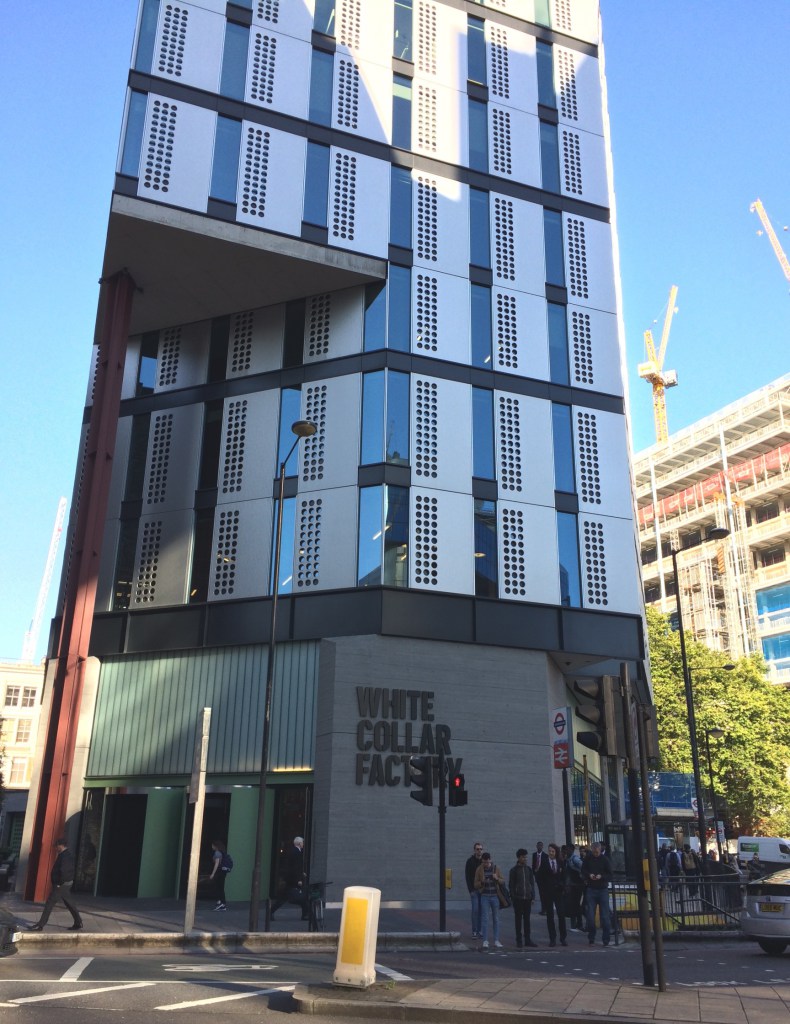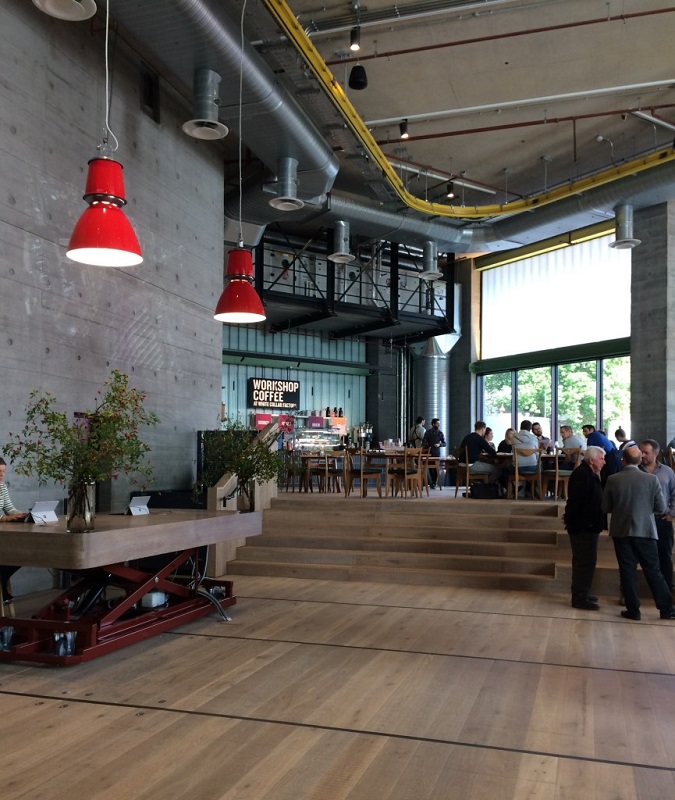White Collar Factory
Eleni Soulti writes about her visit to the newly completed White Collar Factory - 'an inspiring BREEAM Outstanding building'.
In September 2017, I was lucky enough to visit the White Collar Factory, in an event organised by the UK-GBC and Derwent London, giving me a great opportunity to see what integrated sustainability means in practice. With internal and external spaces open to the public, it is a building welcoming not only to its occupiers, but also to the local community.
On the south-west corner of Old Street roundabout, London, White Collar Factory is a 16-storey office tower part of the new Old Street Yard campus comprising low-rise office, retail and residential spaces. A public square connects the buildings and provides open space for building occupants and the public.
The amount of research and time spend on this project, makes it quite unique. The project started in 2008, but was only completed and handed over in 2017. This fact, combined with the ambitions of Derwent London and the project team, allowed for thorough research through the use of a purpose built, £1m, 320 sq. m prototype ‘slice’ of a floorplate.
The prototype was built to test that the concrete core cooling and other design principles would perform as expected. After a year of testing, the team was confident that the principles achieved the expected performance in practice.
As a proof of its sustainability credentials and the way sustainability was woven into the design principles, White Collar Factory started with the intention of achieving a BREEAM 2008 Excellent rating. Thanks to the commitment of Derwent London and the project team and the early consideration of aspects such as climate change impact and life cycle assessment, the project achieved an Outstanding rating under the considerably more challenging BREEAM UK New Construction 2014 scheme.
White Collar Factory has more solid surface than many other tall buildings we see in London’s skyline. This was done in response to climate change, in order to avoid overheating in the summer. Nevertheless, where the orientation allowed, large glazing areas were used, allowing occupiers to enjoy the southern views of the City of London.
The high thermal mass absorbs heat and thus regulates temperature throughout the year. Cooling is achieved through chilled water pipes in the concrete slab, ensuring low carbon, the avoidance of cold spots and quiet operation. Unlike the majority of modern office buildings, windows in White Collar Factory are openable, which means that occupants have access to fresh air and better control over their local environment.
High levels of daylight have been achieved through 3.5 m floor-to-ceiling heights, also providing space for exposed building services. Design flexibility allows building services to be drawn from the slab and adjusted as occupants move in but are easily removed on exit. Moreover, concrete has been used in a triple role – as the means of cooling, structure and finish, which reduces material use and increases resource efficiency.
The way the building has been designed, aims to improve occupant wellbeing and satisfaction, through enabling them to control their local environment, but also through providing facilities for physical activity. Cyclist spaces and other facilities serve those who choose to cycle to work, while a rooftop running track provides space for exercise.
Smart metering is implemented at a very detailed level and is expected to provide valuable information on how the building performs in practice. These results, together with post-occupancy evaluation will examine how the design achieved its intent, improved occupant satisfaction and created an environment of health and wellbeing for the end users.
Overall, modern aesthetics, sustainability implemented in practice and appealing work environments created a very unique, inspiring building.
This article was originally published here on 5th Oct 2017 by BRE Buzz. It was written by Eleni Soulti.
--BRE Buzz
[edit] Find out more
[edit] Related articles on Designing Buildings Wiki
Featured articles and news
RTPI leader to become new CIOB Chief Executive Officer
Dr Victoria Hills MRTPI, FICE to take over after Caroline Gumble’s departure.
Social and affordable housing, a long term plan for delivery
The “Delivering a Decade of Renewal for Social and Affordable Housing” strategy sets out future path.
A change to adoptive architecture
Effects of global weather warming on architectural detailing, material choice and human interaction.
The proposed publicly owned and backed subsidiary of Homes England, to facilitate new homes.
How big is the problem and what can we do to mitigate the effects?
Overheating guidance and tools for building designers
A number of cool guides to help with the heat.
The UK's Modern Industrial Strategy: A 10 year plan
Previous consultation criticism, current key elements and general support with some persisting reservations.
Building Safety Regulator reforms
New roles, new staff and a new fast track service pave the way for a single construction regulator.
Architectural Technologist CPDs and Communications
CIAT CPD… and how you can do it!
Cooling centres and cool spaces
Managing extreme heat in cities by directing the public to places for heat stress relief and water sources.
Winter gardens: A brief history and warm variations
Extending the season with glass in different forms and terms.
Restoring Great Yarmouth's Winter Gardens
Transforming one of the least sustainable constructions imaginable.
Construction Skills Mission Board launch sector drive
Newly formed government and industry collaboration set strategy for recruiting an additional 100,000 construction workers a year.
New Architects Code comes into effect in September 2025
ARB Architects Code of Conduct and Practice available with ongoing consultation regarding guidance.
Welsh Skills Body (Medr) launches ambitious plan
The new skills body brings together funding and regulation of tertiary education and research for the devolved nation.
Paul Gandy FCIOB announced as next CIOB President
Former Tilbury Douglas CEO takes helm.
UK Infrastructure: A 10 Year Strategy. In brief with reactions
With the National Infrastructure and Service Transformation Authority (NISTA).

























